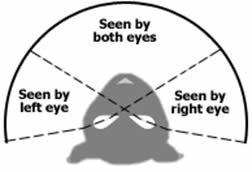I did something foolish. Feeling inspired by all the runners here at the Museum, I signed up for the half marathon. I am in okay shape, and while Carolyn and I sometimes participate in sprint triathlons, I don’t super love the running part. “How hard can this be?” I thought, “I’ve got months to train!”
Not quite.
Because Dave and I will be in Africa for most of November, I will have to take a break from running. Why, you ask? I’ll have my feet with me, right? Surely I will take some sneakers…
Because only prey runs.

Courtesy of National Geographic
 In Africa, lions, leopards and cheetahs are some of the biggest predators around. What makes these big cats such apt hunters? One adaptation of note is binocular vision. The cat’s eyeballs are proportionately larger than other carnivores. Even the common house cat can open its pupils to a maximum area three times larger than a human’s. In fact, in the right conditions, a cheetah can see up to 3 miles away. This means that the hunting instinct in cats is first cued by movement.
In Africa, lions, leopards and cheetahs are some of the biggest predators around. What makes these big cats such apt hunters? One adaptation of note is binocular vision. The cat’s eyeballs are proportionately larger than other carnivores. Even the common house cat can open its pupils to a maximum area three times larger than a human’s. In fact, in the right conditions, a cheetah can see up to 3 miles away. This means that the hunting instinct in cats is first cued by movement.
 A house cat has 287 degrees of total vision with 130 degrees of binocular vision, while a human has about 200 degrees of total vision with 50 to 80 degrees of binocular vision. The extended scope of a cat’s vision makes them much better hunters, enabling them to judge distances more accurately.
A house cat has 287 degrees of total vision with 130 degrees of binocular vision, while a human has about 200 degrees of total vision with 50 to 80 degrees of binocular vision. The extended scope of a cat’s vision makes them much better hunters, enabling them to judge distances more accurately.
A weakness in the big cats, however, is endurance. Lions, cheetahs, and leopards are all built for short bursts of speed, but they cannot sustain the efforts. Lions, for example, have relatively small lungs for the size of their bodies so they fatigue fairly quickly.
Don’t be fooled, however: those short bursts of speed can be amazing. Leopards can reach 45 mph, lions can reach almost 50 mph, and cheetahs a whopping 74.6 mph. In fact, cheetahs can reach 60 mph in 3 seconds and can cover 20 feet in a single stride. So while the endurance isn’t long lived, it is impressive and impossible to outrun!
So what do you do if you find a lion on your trail? Experts recommend standing your ground, avoiding eye contact and slowly backing away. If the big cat continues after you, move your arms, shout and try to make yourself look bigger. Either way – don’t run and don’t play dead. Lions are happy to scavenge and delighted to chase!
When I return to running in December, I will have to double up my efforts. Perhaps I can pretend a lion is chasing me for extra motivation.






